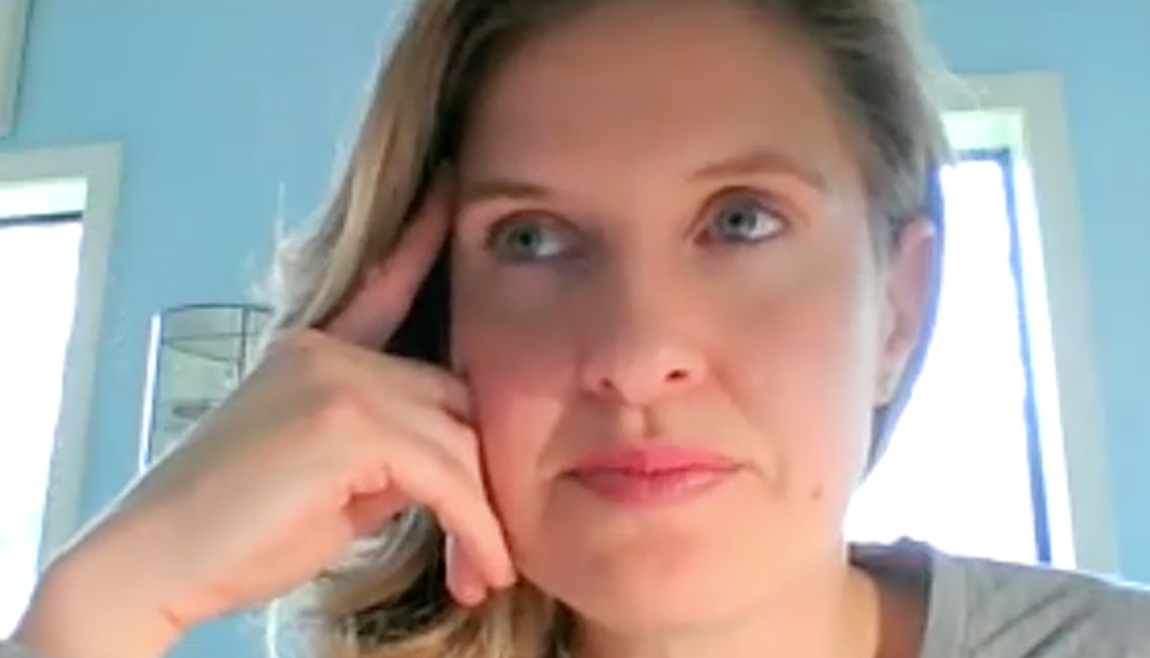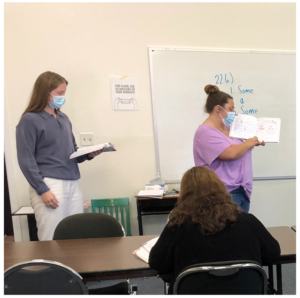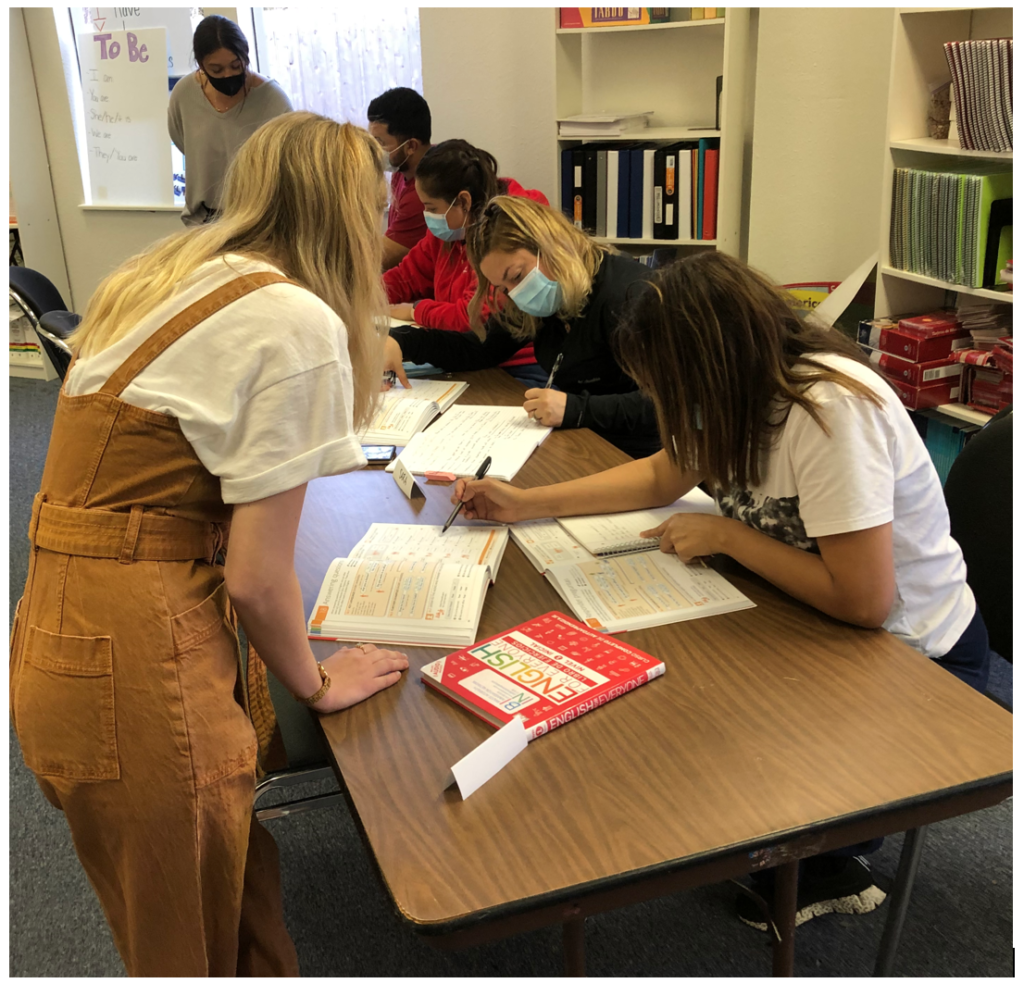Q & A with Conversational English teacher, Julia Lynch
BIIN is fortunate to have a strong corps of volunteers serving as English teachers this spring. One of them, Julia Lynch, has designed her class so that it benefits teachers in training at Texas A&M University as well as the adults learning English at BIIN. To learn more about Julia’s story and what she and her students bring to the Conversational English program, BIIN staffer Janet Morford sat down to talk with her. Their conversation has been edited for length and clarity.

At Texas A&M University, you are a lecturer in the Department of Educational Psychology, which is part of the College of Education and Human Development. Yes, that’s right. Since when have you held this position? I started in the Fall of 2019.
What kinds of courses do you teach? I teach ESL Methods 1 and 2. These are undergraduate courses, required courses, for students who are looking to become teachers. With ESL methods 1, we work with the adult population, and with ESL Methods 2, we work in the K-12 context, in schools.
Who are your students in these classes? It’s usually for the general population in Texas, K-12. Some of my students are interested in becoming special education teachers, but they also need to train for working with English language learners. And we have a few students who just plan to work with children: in children’s ministries in churches, and camp counselors in camps, and so on. So I do have some students who will not be teachers per se, but will definitely be working with children.
I’m particularly interested in hearing more about the ESL Methods 1 class that you are currently teaching. Could you explain the goals of this course, in ways that might make sense to non-specialists? These courses are very popular for our pre-service teachers (potential teachers in training). The purpose of ESL Methods 1 is to introduce them to the theories of second language acquisition and learning. So we learn theories about how people acquire second languages, we learn the histories and the policies of bilingual education, we learn about how culture and language tie together, and how to support children, their families and the communities that include the English learner population.
For this course, students have to complete 5 hours of service learning. And so their participation in BIIN’s English classes with me fulfills those 5 hours. (There are more than 120 students in the class; but twenty-some can sign up to do service learning by helping with the Conversational English classes that Julia Lynch teaches at BIIN.)
Otherwise, most of the students in the class have “conversation partners” – they are paired with international students, usually grad students, at Texas A&M, and they have 5 hours of conversation with those students throughout the semester. In the past, we have also partnered with other community organizations that provide ESL classes.
In the past, how have you tried to help your students understand and prepare for the task of teaching English to adult learners? Mostly it’s through those conversations with the international students. In class, we talk about the different aspects of language, the different hypotheses about second language acquisition, about psychological and individual factors impacting language acquisition, you know, barriers and motivations for learning English. So they’re reading about that and we are talking about that. And then as they do their service learning hours, they reflect on that, and look for examples of those things. Then they write a case study, a research paper.
As opposed to children, who often pick up new languages easily, what are the challenges that adult English learners typically face? There’s the anxiety of learning a second language: the fear of speaking, the fear of not understanding what’s said. So anxiety is a big factor. Motivation is also a topic that comes up. My students are very interested in seeing how motivated these adult learners are, and that doesn’t have to do with socioeconomic status, that doesn’t have to do with age, you see learners across the board that are highly motivated. They have different individual factors, but motivation is central to all of them.
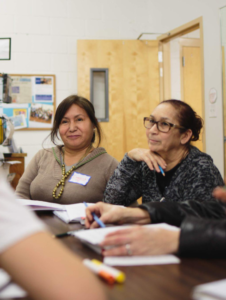 For BIIN’s population – and this is true for immigrants in my experience, this is true with child immigrants too – one of the barriers is that often they have had limited formal schooling, or limited access to formal schooling. So sometimes with the adult learners at BIIN, you’ll notice that in terms of their literacy skills, they’re novices. And that can be an impediment, since we are working with books, asking them to write down answers, and things like that. And that’s a challenge – but it’s great for them to be in those courses because they are practicing those literacy skills at the same time! So I just ask my students to be aware that some of the learners at BIIN are going to need help with the writing and figuring out how to organize exercises in their notebooks, and things like that.
For BIIN’s population – and this is true for immigrants in my experience, this is true with child immigrants too – one of the barriers is that often they have had limited formal schooling, or limited access to formal schooling. So sometimes with the adult learners at BIIN, you’ll notice that in terms of their literacy skills, they’re novices. And that can be an impediment, since we are working with books, asking them to write down answers, and things like that. And that’s a challenge – but it’s great for them to be in those courses because they are practicing those literacy skills at the same time! So I just ask my students to be aware that some of the learners at BIIN are going to need help with the writing and figuring out how to organize exercises in their notebooks, and things like that.
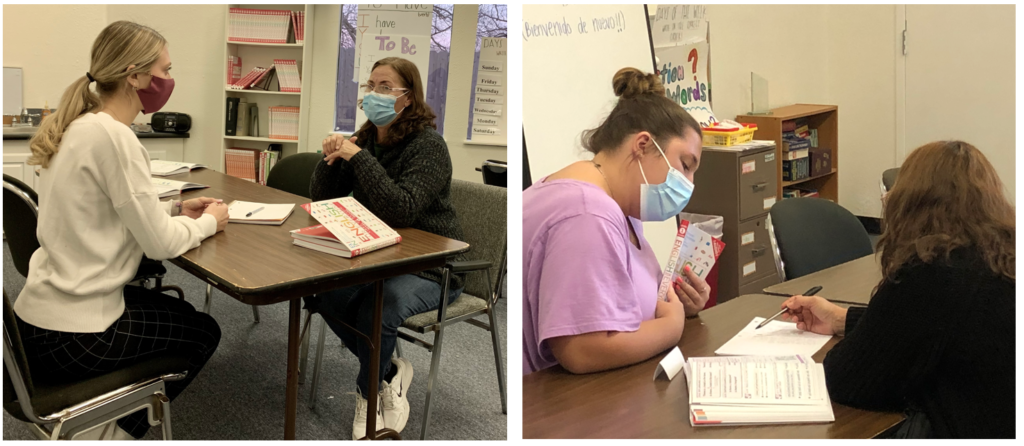
And what about novice ESL teachers: what are the challenges that they typically face, as they learn to be effective teachers? They have no idea how much they speak, and how fast they speak. They have a really hard time simplifying their language, and speaking clearly and concisely. I tell them on the first day, “Of course you want to speak to your learners in English, but don’t talk too much.” They want to explain this game or this exercise, and I say, “You don’t have to do that. Just point to it and say, ‘Number one,’ and start going.” Every single one of my pre-service teachers, when they show up, they get up there, and they ramble. Every single one. They have to learn to empathize with language learners, and that means: being a compassionate speaker.
So that’s one thing, and then the other, is just the general nervousness. 100% of my students, when they show up on the first day, they are nervous about it. They don’t have much experience with teaching – if they do have experience, it’s with children, maybe in Sunday School or some substitute teaching. But they know they are walking into a situation where they will be speaking with people who are older than they are. On the second day, when they get there, I tell them, “I’m not going to teach much today.” And they have to do it (lead the class). They still ramble a little bit, but it’s less, they still are nervous a little bit, but less so. It’s great to see!
When and how did you first learn about BIIN? It was a very long time ago that I learned about BIIN, through people in the community. Tony Caraballo was probably how I learned about BIIN. He was my academic advisor in Hispanic studies at A&M starting in the early 2000s. He was always a strong advocate for us as students and also he would talk with us about the community, and talk about these issues. I did volunteer as a “conversation partner” in BIIN’s English classes and in the citizenship classes, probably 5 years ago.
How did you realize that BIIN could offer your A&M students a realistic environment in which to practice their skills as new teachers? A colleague and I talked about it, before Covid, when the students could be “conversation partners” in in-person classes – this was in 2019. I had already been a conversation partner at BIIN and knew what that would be like. The purpose of our ESL methods 1 course is to help them get their feet wet, help them overcome any anxiety they might have about working with language learners. We just wanted to expose them to that environment. Then with the pandemic, our students stopped going to any community-based face-to-face classes, but they could meet with the international students on Zoom.
In late fall 2021, I got your email, your outreach to the university, looking for people who could help teach English classes at BIIN. I think it was forwarded to me by one colleague, and then by another. And I thought, “No one else is saying they’ll serve in this capacity right now. So I guess I’ll do it.” It makes a lot of sense for me and the ESL professors because we have our students doing this anyway.
Volunteering to teach an ESL class means devoting multiple hours a week. How did you decide that you were willing to take on this role at BIIN? It’s just part of my belief system. Before I make decisions, I pray about it and I just think, “Is this something I believe in? Is this how I want to live my life? Do I want to be a service-oriented person devoted to others, or just kind of enjoy time to myself?” Honestly, it’s a struggle sometimes, because I know there needs to be a balance for me. I have to be able to devote myself to my students because that’s my job, but also, just as a person, I know I want to be a person who is giving my time and love to other people.
We are very grateful that you are that kind of person! So, you have been teaching the Level 1 class since January 2022. How has it gone so far? It’s fantastic, just fantastic! In terms of the rapport and community we’ve built with the BIIN learners and also with my students, it’s been wonderful on both of those fronts. My connection with my A&M students is fuzzy, honestly, unless I do things like this with them – because I have over 120 students, but only about twenty-some students who sign up to help teach at BIIN (one week in the semester). And so, working with them for several hours in that week, it’s been a really good opportunity to get to know them on a deeper level.
The A&M students come to BIIN two nights in one week. I’m the only one who is there from week to week with the BIIN learners. And we’ve gotten to know each other. We have our jokes, we have our fun times, and there’s a great work ethic in there, and so it’s pretty cozy by now. We definitely have some good times.
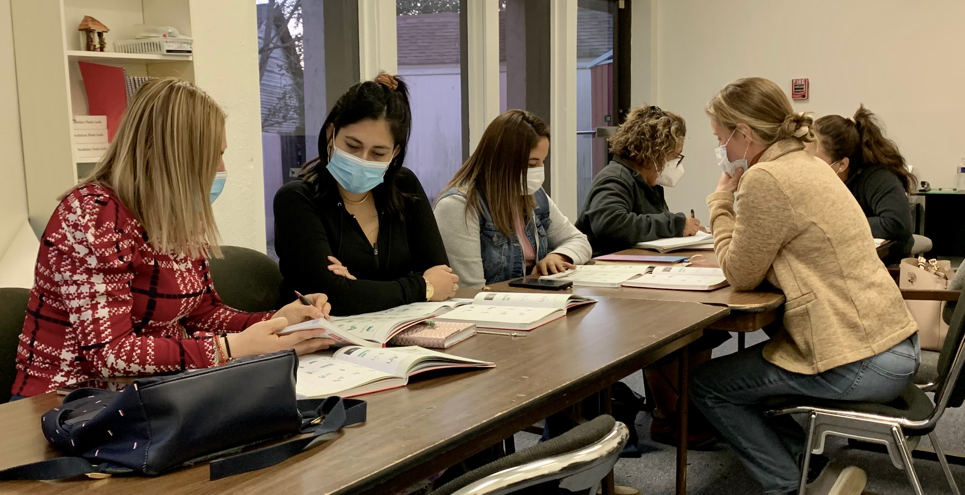
What’s a typical week like for you, as lead teacher for the Level 1 English class, which meets in person at BIIN? A typical week for me, regarding my A&M classes is: beforehand, I make sure I’ve read the chapter and the materials for the A&M students, I prepare my lectures and assignments (for TAMU students). The community and the classroom environment is really important for me. Sometimes we work hard, and sometimes we just get to know each other.
For the students who are teaching at BIIN, I’ve already emailed them the scaffold, so the visual aids or things that I want for them to bring to enhance the lesson. They’re not totally necessary, but I want the students to contribute something. So they come prepared with charts and posters and pictures and flashcards and things like that.
They show up 30 minutes before the class starts. I go over the lesson plan for that day with them. It’s not anything complicated. We look at the activities (in the textbook), and we divvy up the work. I tell them, “You’re going to lead this activity, and you’re going to lead this activity…” When one person is leading an activity, the others are floating around the room, helping learners.
I tell them, “This is the cycle: you model the activity, then the learners work on it individually, then they share with a partner, and share with the class.” I try to teach them that cycle, as a way to get as much as you can out of each exercise (in the book). It’s really straightforward, but they do have to learn how to manage the time – how to keep everyone on the same page, and make sure everyone is grasping it, but also not just sitting around waiting. I try to teach them about pace: take things slowly, but you’ve also got to keep marching.
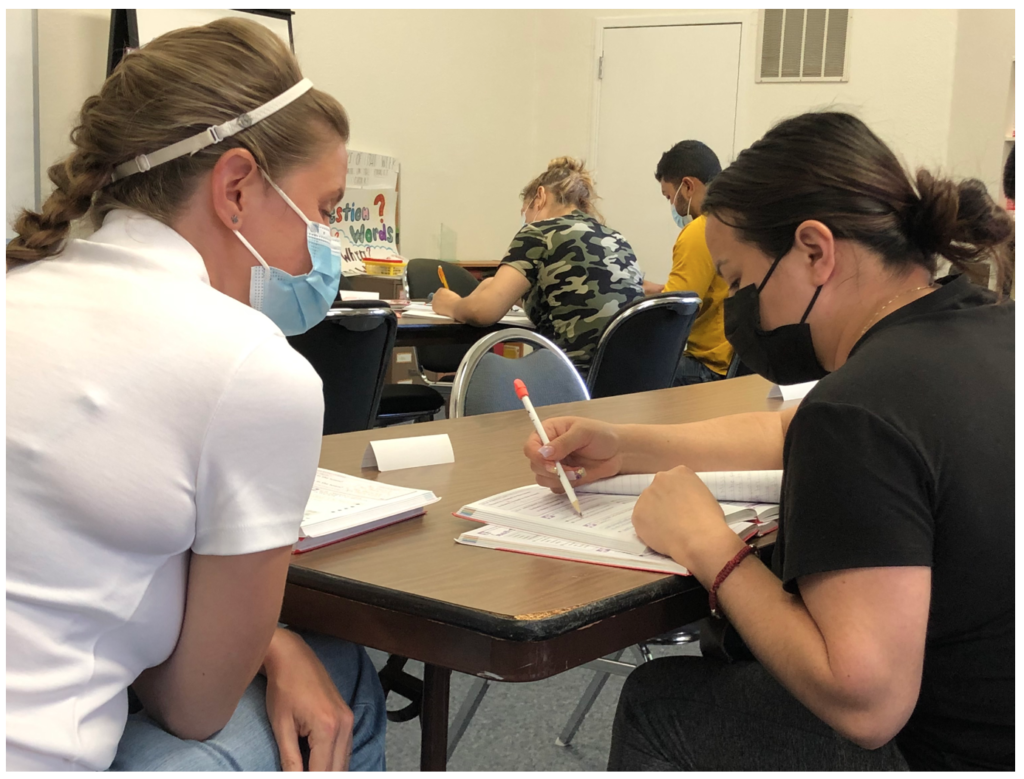
Due to concerns about the Omicron variant, you were given a choice between teaching online or teaching in person, with masks. What led you to choose to teach in person? Just because I have never been as successful at building the same kind of environment online as we have in person. And so, I wanted for my students to have that experience, of what it’s like to be in a classroom with people, I wanted them to get acclimated to that environment.
Are there ever questions about BIIN’s rule that masks need to be worn inside? No, there have been no questions about the mask rule. I just remind the students, “Please arrive at 5:30, please wear your mask, please bring your poster or whatever you made.” The Aggies are wonderful students, they are so respectful and they are service-oriented. I’ve been proud of them.
The adult learners are very grateful to be there, and in fact, if we do contact a learner from the waiting list and invite them to join us, they’ll say things like, “Oh, this is such a great opportunity! I was waiting for this and hoping for this!” It really means a lot to them.
What have you learned or observed about the adult learners taking the English class? What motivates them? They really want to learn English. Most of them are intrinsically motivated, they seem to be interested in grammar rules, in vocabulary, in pronunciation. But I don’t think that [at this level] they are necessarily trying to get other jobs right now. They are just really motivated to learn. I think quite a few of them have children, they are motivated by their children and want to help their children in school, or model lifelong learning to their children. And then, like I said, one of the older students likes the social aspect of the class.

What do you appreciate about the adult learners as students and as members of the broader community? I do appreciate the diversity of BIIN: we have learners from Mexico, Honduras, Venezuela, and many more places. One of the participants was a school teacher in her home country. So we have some who are still developing their literacy skills, and then we have other people who were working professionals in their countries. I knew that about the immigrant community, but you see it on display at BIIN. My A&M students see that – that there is really a lot of diversity among English learners.
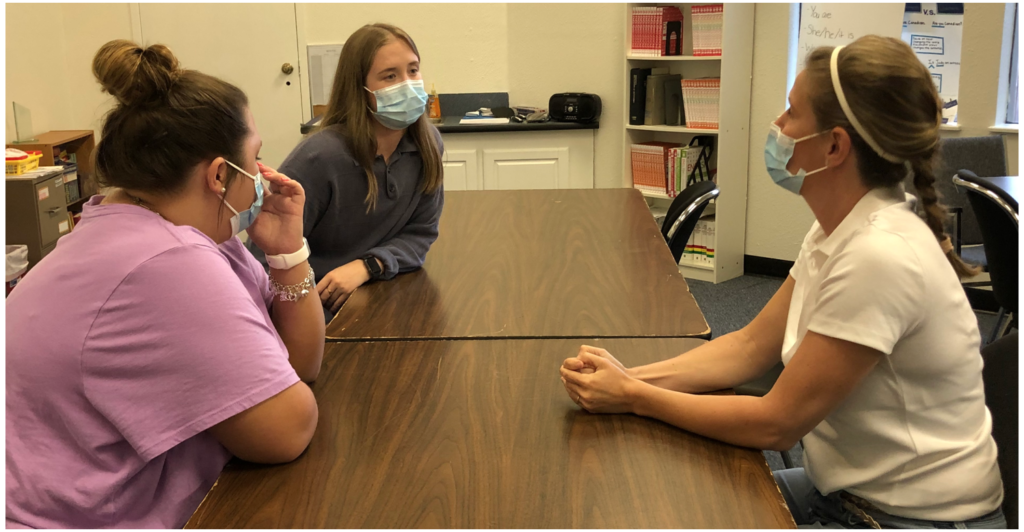
How do you use the time before and after class to help your TAMU students prepare for and reflect on what they are learning? Before class, we go over what we are going to do. That helps calm them down. I remind them, “I will tell you what to do.” And then afterwards, it’s one of my favorite parts: the BIIN learners leave, and then the A&M people, we sit down and take a breath, and we just enjoy that feeling of “We worked hard!” Then I ask them, “What did you notice?” And I just listen and see what they talk about. Sometimes they talk about individual learners, sometimes they talk about things in general or certain activities. Then I usually follow up with, “What was the best moment of class?” for them.
They are also writing a paper. It includes a literature review about best practices for adult ESL community programs. Then they write a reflection about the scaffolds that they create for the class, so those posters, visual aids, flashcards and things I’ve asked them to make. I ask them to reflect on how those helped the students, what they noticed about the students using them. And so their reflection is based on those physical items they created, and thinking about how the learners interacted with those. And they end with a personal reflection about the experience and any recommendations they have.
This is clearly a unique kind of partnership: student teachers learning to teach, by working with adult learners in a non-profit setting. Is it something that you would be willing to do again, or that you think other people (faculty, students, teaching training programs, etc.) might want to emulate or get involved in? Yes, I do. It’s the best way for our students to learn. Hopefully, most of their learning at A&M is going to be experiential, so they feel they’re ready to go into their roles, as teachers or community leaders or ministers or whatever they’re going to be. They can at least say, “I’ve done this before… and I survived.”
Hopefully, people will do it, and I plan on writing about it: I hope to write a short “how to” article for a TESOL journal or newsletter, to tell others, “Here’s what I learned,” to lay out the steps (of working with students to teach ESL for a non-profit).
I think the number one thing is just to keep it simple. With my students, I’ve learned not to give them too many options, just to tell them what I want from them. And so in class, we use the activities provided by the textbook series. Keeping it simple makes it do-able and enjoyable.
Is there anything else that you would like to share about your experience as a volunteer teacher of Conversational English at BIIN? It’s been fun, so enjoyable, it’s so rewarding. Even though it is a couple of hours, two nights a week, it’s always worth it. That’s one of the best feelings: ending the class, coming home, and you feel that sense of fulfillment. In my opinion, it’s more fun than whatever else people do in the evening, or other things I do in the evening, like watch TV or whatever. Sure, it’s volunteerism, but it’s just fun!
One of the most fulfilling things is to hear my A&M students, when they say, “I want to be an ESL teacher now! I loved it so much! I don’t want to stop. I want to do it all semester!”

